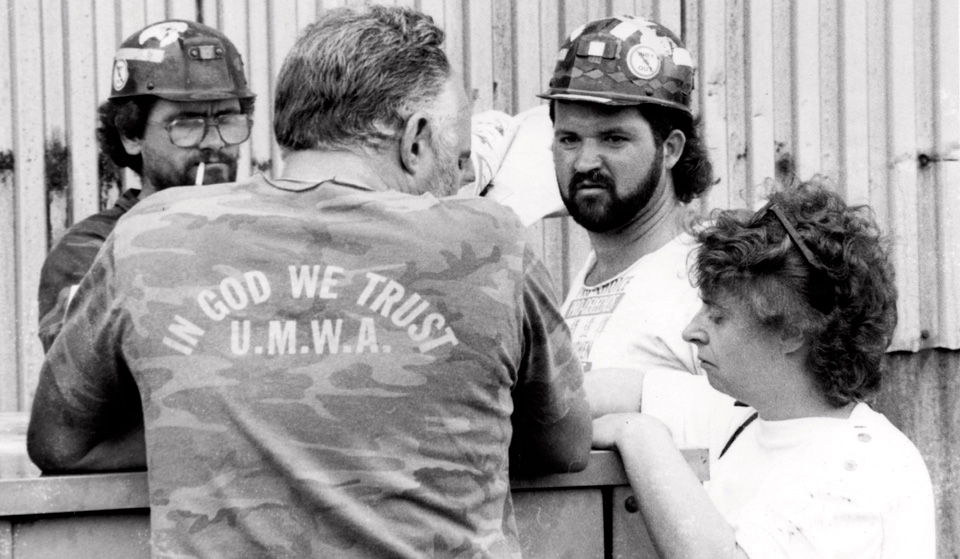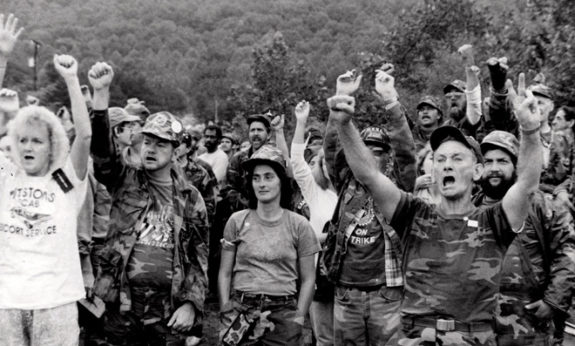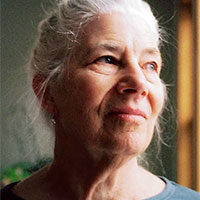
Defeating the Trump agenda is going to require winning a section of working class voters who supported him – mostly white – undoubtedly influenced by racism. To get there, it’s going to take more than just rejecting that divisive influence; it’s going to take strengthening working class identity.
The election made me remember back to 1989. My husband Scott and I decided to make that year’s family vacation a trip to the mountains of West Virginia, to Camp Solidarity set up by 2,000 striking coal miners. Their employer, the Pittston Company, had eliminated health benefits for retirees and widows, blaming decreasing coal prices. The miners were occupying the mine’s tipple, its coal-loading platform. Camp Solidarity rallied supporters and donations from around the country and around the world. We wanted our kids to see for themselves what solidarity looked like.
As our old van made its way to the top of the mountain, I was struck by how different this work location was from the urban factories and mills Scott and I spent our work lives in. The giant Freeway Flyer buses with New York, New Jersey, and Pennsylvania license plates that kept passing us looked out of place on a switch-backed, two-lane road. At Camp Solidarity, we found a well-organized operation directing traffic and parking.
“Welcome folks,” said a tall, wiry, middle-aged miner. He leaned into the open driver’s side window and introduced himself as Jim. Taking note of our license plate, he went on, “I see you folks have come a long way, from Illinois. I used to live near there, near Burns Harbor in Indiana. Know it?”
Seeing a connection, I jumped in, “Did you work at Bethlehem Steel?”
“Yup, seven years!” Then why did you leave, we asked. “Well, I came back here when they began to move in, all these…” He paused; nearby hundreds of stiff-kneed travelers were tumbling out of the buses: AFSCME, SEIU, steelworkers, mostly African American. He looked at us; he knew we knew what he had been getting ready to say. “But,” he drew himself up and a little pride entered his voice, “I don’t feel that way anymore.”
I wondered about Jim after the Donald Trump election. Did he remember the experience of solidarity? Or was his vote motivated by fear and hate?
Why Trump?
We know that a majority of white voters – in all categories – voted for Trump. Men, women, young, old, and yes, working class. Who are these folks and why did they vote for a conniving billionaire?
Well, it’s undeniable that there is a consistent, hardcore right-wing racist movement with a deep historical base in our country. The liars. The bullies. These haters made up the core of the Trump supporters; they were the rally-goers. But these hardcore supporters were only a fraction of the Trump voters.
So what about the others? The ones who voted for Barack Obama in 2008 and 2012. The ones who really take to heart their Sunday school lessons, “Red and yellow, black and white, we are precious in His sight.” The ones who want their daughters to have full equality. The ones who will be warmly welcoming the LGBTQ members of their families at their tables this holiday. The ones who remember their own grandparents were themselves immigrants.
Racial isolation
Statistics show the white voters who supported Trump are concentrated in racially-isolated zip codes. They don’t have day-to-day contact with black people, with immigrants, with people from the Middle East.
They don’t listen to NPR either. Instead, they’re inundated with Fox News, hateful talk radio, and fake online news. “Black Lives Matter thugs attack homeless veteran in Charlotte” was the headline of one such fake “news” video that got over a million views. In it, an elderly white man is kicked by a group of black teens. The footage had nothing to do with BLM; it was years old, filmed in London. But to those who viewed it, those made vulnerable by a culture of racial stereotypes, this horrible image became a fact that influenced their choices.
These Trump voters live in areas where there is little social structure that supports progressive thinking. Churches, with a few heroic exceptions, by and large don’t play a positive role. Often the moral guidance from right-wing evangelical churches is limited to one issue when it comes to voting: abortion. When candidate Trump evoked the mental image of babies being ripped out of their mothers’ wombs, it resonated.
Unions don’t have much of a presence in these racially isolated areas. Nor do other social movements like the Fight for $15. People here – whether in factories or fast food restaurants or call centers – don’t work side-by-side with immigrants or people of other races. Yet the people there face the same anxieties all American families face. What kind of jobs are their kids going to get? The drug scourge. Their health, their retirement. They care about the climate too, and their kids’ education.
A tolerance for the intolerable
Millions made a bad, ill-informed choice in this election. We have to deal forthrightly with the fact that a significant percentage of our working class voted for Donald Trump despite his hateful rhetoric toward African Americans, Latinos, Muslims, and women. Trump got more votes than Romney did in 2012, roughly proportional to the increase in the overall number of voters. This is disturbing, given Trump’s much more extreme, direct, racist, anti-immigrant, and misogynist appeal. The increased vote for Trump is evidence of a troubling tolerance of what should be intolerable.
We are repelled by the failure to reject hate, but we can only reverse the Trump agenda by reaching out to these same voters in racially-isolated communities. There’s not four years or even two years to wait.
When the shit hits the fan with Social Security, Medicare, and VA privatization, lost health care, and declining standards of living, the same lying manipulators who worked the media for Trump in the 2016 election will attempt to direct folks’ anger toward the same scapegoats: African Americans, Muslims, and immigrants. They will use the same narrative to take the Trump agenda out of the line of fire. More on that in a bit.
Half a million missing votes
Trump won the electoral college vote in five Midwest battleground states – Wisconsin, Ohio, Michigan, Pennsylvania, and Iowa. A combined total of one million voters who had previously voted Democratic, for Pres. Obama, did not vote Democratic for Hillary Clinton. Half of them added their votes to the Trump total this time. But what about the other half? What did that half million do?
Countless Midwestern voters – it’s hard to say how many – who were Democratic voters in 2012 were knocked off the rolls by a methodical GOP suppression campaign in these battleground states.
Of the remainder, there were others too who couldn’t bring themselves to vote for Trump but didn’t come out for Clinton either. Some of the former Democratic voters chose third party candidates – either Libertarian Gary Johnson or the Green Party’s Jill Stein. They chose not to vote for Clinton, but nevertheless these former Democratic votes cannot be counted as a vote for racism or xenophobia.
Some may have been driven away by the venom of the campaign and not voted at all. No exit polls are taken of people who don’t vote. It’s important not to exaggerate the Trump vote, especially among the working class.
“Backlash”?
And I find no evidence of a phenomenon cited by other commentators, that Trump’s appeal was primarily based on a backlash to a black president or an increasingly multi-cultural society.
Our challenge is to win the unity of the working class. How do we reach out to these people?
I think first, we have to know that ALL of us, like our coal miner friend Jim, are of two minds about many things. People like him believe in humanity, in being generous, in the brotherhood of man and woman, in peace, in neighborliness.
Many embrace the beautiful image of the Statue of Liberty welcoming refugees from poverty and oppression. They are troubled by news reports and videos of unarmed black youth shot in the back by out-of-control police or vigilantes. But they are also influenced by the awful stereotypes they’re inundated with – Islamic terrorists, crime-ridden “inner cities,” dangerous immigrants.
Only working class consciousness – embracing one’s primary identity as a member of that 99 percent majority of Americans who own nothing but their ability to work – fully addresses this challenge. This means identifying with a working class that covers diversity from one end of the beautiful rainbow of humanity to the other.
This is the only foundation that can fundamentally challenge the influence of racism and other ideological influences that undermine working class unity. This kind of consciousness is the protective vaccine needed to resist the poisons of racism, misogyny, and xenophobia.
Lessons from what worked
The working class movement in the U.S. is not starting from scratch in taking on the duality in thinking on matters of class and race. In fact, alongside being the source of the sharpest racist ideology, our country also has a heritage of developing a fight against racism, one that includes winning white Americans, especially white workers, away from that poisonous and suicidal ideology. We also have a long history of fighting for the rights of immigrants and for women’s equality.

There are lessons from our people’s struggle, be it against the 19th century slavocracy or the 20th century Jim Crow, that held the key not only to equality, but to improving of condition of white workers:
- 1. Resist. Don’t sit back and wait to see what happens.
- 2. Defend all targets. Every hate crime and act that goes unchallenged strengthens the base for fascism. On the other hand, engaging folks in the democratic and humanistic struggles against this disunity changes the thinking of the people themselves. Just as a person who has walked a picket line is never the same, a person who has signed a petition, gone to a public hearing, or spoken out against injustice is changed.
Let’s look at the case of the nine African American youth who were being railroaded to a death on a fake rape charge in Scottsboro, Alabama in 1931. Our predecessors, up to their necks in building the CIO industrial unions of steel, auto, and packing house also spent the decade of the 1930s making the case to their co-workers that unionization could not succeed without unity – and their banners read: “Black and white unite and fight.” In the same demonstrations, white and black workers carried placards calling for freedom for the “Scottsboro boys.” For those white workers, fighting racism against the Scottsboro youth helped cement the unity of those workers.
- 3. We need to pay special attention to mass movements that can resonate in racially-isolated areas. For example, the Fight for $15. The majority of those who make less than $15 per hour are white workers. They are fast food workers, Walmart workers, nursing home and, yes, factory workers in towns, suburbs, and rural America. Planned Parenthood has a loyal following and is represented in every state and D.C. Public education is under assault everywhere. There is a basis for national unity there.
- 4. We have to take the initiative in the fights to defend Social Security and Medicare – and Obamacare – to the communities in these areas that are politically vulnerable.
- 5. We can’t wait for elections. During elections, tactics demand that efforts be concentrated on getting votes where they are most plentiful, so little door-knocking is done in more challenging areas. Working America has done pioneering work in initiating year-round doorstep conversations.
This is not an easy fight, but look what’s at stake. It’s not enough to analyze and reject the racism, xenophobia, and misogyny of members of our class. Our job is to figure out how to turn it around. But there is no path to unity that doesn’t go through that process. We need all the Jims of the world on our side.










